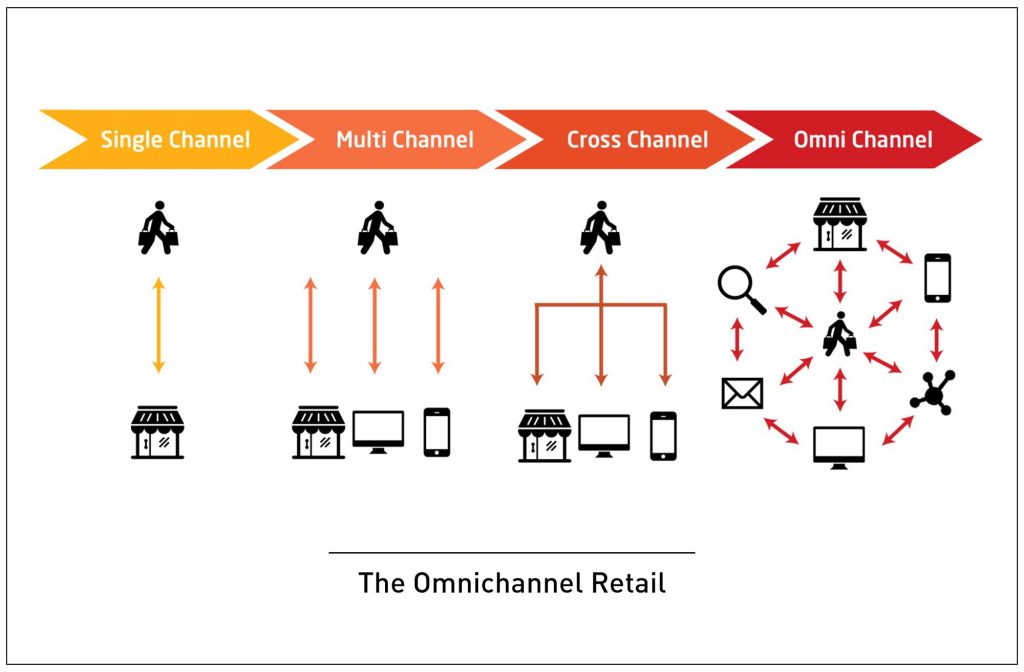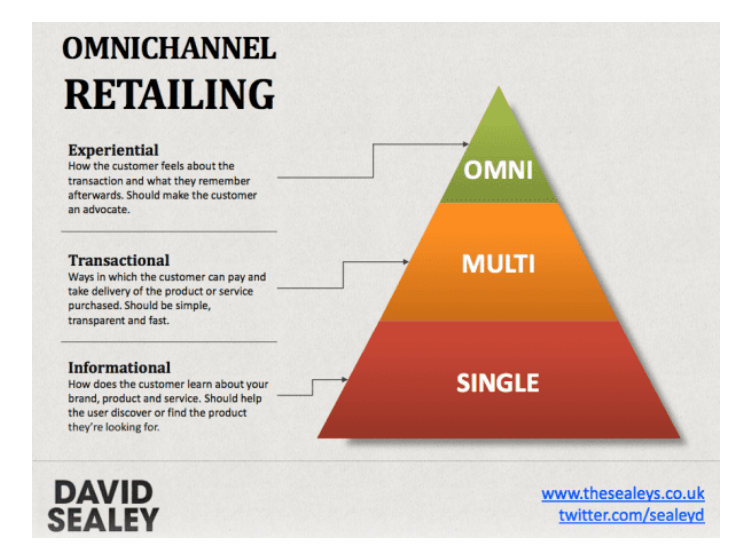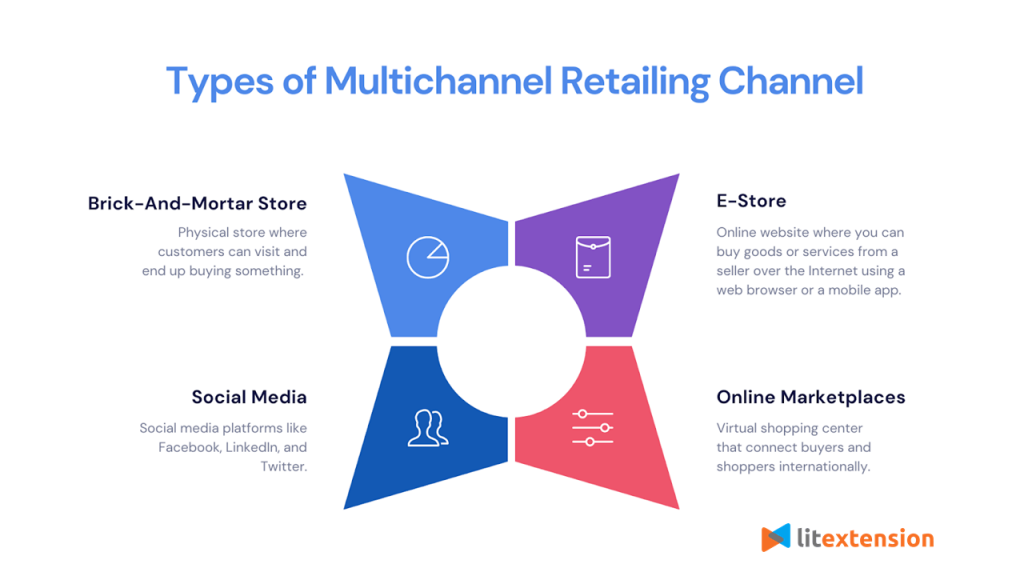Simply by association, omnichannel retail sounds far more sophisticated and complex than multichannel retail. But when it comes to Omnichannel vs Multichannel, which one is better?
It’s also more fashionable these days. It’s the gossip of the town. Or, at the very least, anyone who wants to get the most out of physical and online commerce should be discussing omnichannel vs. multichannel retail.
But, first and foremost, what is omnichannel retail? What makes it unique from multichannel retail? What does each look like in practice, and which is the superior option?
The truth is that either strategy can succeed if properly implemented. Both tactics have advantages, so it comes down to how feasible, scalable, and effective each strategy is for your company. We don’t have to declare one superior to the other as long as we’re all working together.
What is Omnichannel Retail, And How Does it Work?
Omnichannel retail is a type of integrated multichannel commerce that allows data to be synced across channels. The process of connecting a store’s brick-and-mortar operations with its internet company is known as omnichannel retail.
It can be part of a bigger commerce and marketing strategy that connects the numerous touchpoints of customer and brand contact and ensures data is passed across them. The interaction of many channels with each other and with the customer is the emphasis of an omnichannel strategy.
Customer and product data are synchronized across channels in an effective omni channel setup. The ultimate goal is to make every engagement with a brand across different channels feel like it’s all part of one seamless experience for the customer.
A brand’s entire omnichannel marketing strategy involves two-way interaction between online channels and physical locations, as well as handoffs between online channels.
A physical location should be able to transmit relevant and accurate data with an online channel, such as available inventory.
Similarly, an online channel should be able to provide critical information to a physical location, such as when a customer places an order for pickup.
A customer should be able to proceed from discovering a product to purchasing it through any channel, including a physical store, an internet store, and even social media. When a customer takes action, there should be additional marketing possibilities and enhanced brand contact.
There are many various ways to deliver an omnichannel experience, and the methods employed vary widely depending on the nature of the business and the clientele.
Businesses can think beyond the box and provide an experience that a customer wouldn’t get from buying on a single isolated channel.
The combined strengths of numerous channels have created new and enhanced choices for customer engagement.
Despite the fact that “omni” means “all,” omnichannel retail isn’t always about being everywhere at all times.
Customers should be at the core of an omnichannel strategy, which should meet them wherever they interact with the company, including in physical places as well as on desktop and mobile devices.
It would be pointless to develop a marketing strategy for a channel that customers do not use.
Technology is frequently a stumbling block to implementing a successful omnichannel strategy. It takes a lot of effort and money to establish the correct integrations, collect the right data and maintain it up to current, and then design strategies around that data.
Fortunately, there are more alternatives for providing a smooth commerce experience to customers now than ever before, and businesses don’t have to construct these solutions themselves.
According to an Arlington Research research, 49 percent of omnichannel merchants plan to outsource their omnichannel operations in some form in 2020, and more than half want to outsource their omnichannel operations in the future.
How Does Omnichannel Retail Work?

Omnichannel retail involves a variety of techniques and features, but in general, it relies on data being collected and distributed across several channels so that customers’ experiences are consistent no matter where they contact with a brand. Customers can sometimes continue their trip where they left off thanks to channel integration, almost as if the company “remembers” them.
Although omnichannel solutions have the ability to provide a memorable experience, a solution that doesn’t operate as intended can leave a negative impression on the customer. According to Microsoft, 58 percent of customers have discontinued doing business with a company because of a negative customer service experience.
To boost client retention, make sure that each phase of the customer journey is as smooth as possible.
These are the basic steps to adopt omnichannel retail:
1. Determine customer touchpoints and opportunities for increased brand connection.
Adopting a customer-centric approach to your business might help you spot chances to provide customers with a more convenient or personalized experience. The point of sale is just one of many touchpoints in the customer’s journey. Brands can improve brand loyalty by making a positive and lasting impression before and after the sale. It’s also feasible to add extra touchpoints to the customer journey or divert clients to a better alternative for continuing current behaviors.
2. Create a plan that revolves around the customer experience
Determine which processes must be carried out in order to provide a high-quality client experience. What are the system’s problems and probable flaws? What is the aim of the brand at each stage of the customer journey? How many different touchpoints can lead to new or recurrent customer interactions?
3. Link systems and individuals so that data may be passed back and forth
Everything is connected by good data, and using the right tech stack is often necessary to preserve high-quality data across platforms. To highlight which products are now available for curbside pickup, for instance, a retailer would need to effectively maintain in-store inventory, deliver the inventory values in a product feed to the ad channel, and continuously update the inventory values as they change.
Establishing a system for informing staff at the physical store about new orders and having someone on standby with the knowledge to handle any problems that may emerge are both essential in this situation.
4. Put the strategy into action
This could be a multi-step procedure, depending on the goal and which stage of the client experience is being addressed. A customer might be introduced to a loyalty programme or given the opportunity to open an account for future incentives during an in-store transaction, for instance. In an omnichannel strategy, customer service representatives on social media channels should be able to help with account concerns since a client profile is accessible in-store, on mobile, and on desktop devices.
5. Gather and analyze further information
In a fully integrated omni channel arrangement, every customer action results in an additional brand action. Data gathering enables businesses to assess interest, ascertain the client’s position in the customer journey, and choose the best course of action for fostering a relationship.
As networks like Google and tech businesses like Apple react to concerns about consumer privacy, the methods for tracking consumer data are changing. First-party data is increasingly more crucial when third-party cookies become less prevalent. First-party data is frequently obtained when users want to provide additional information about themselves.
Although convincing potential clients to divulge more details might need some cunning, those who do so have already expressed an interest in deepening their relationship with your business and are therefore more valuable in the long term than those who don’t.

What is Multichannel Retail, And How Does it Work?
Multichannel retail is the practice of marketing products through multiple channels. It is possible to use digital, physical, or a mix of the two channels. A business can sell goods online, in person, and on other platforms or marketplaces.
A corporation can reach out to more clients through several channels while keeping the same product inventory by using multichannel selling. It’s important to note that retailers can set aside certain quantities of inventory for various channels, as well as adjust and optimize product descriptions, images, and other attributes for each channel.
A multichannel marketing approach that engages customers through email, social media, the company website, and other channels can include a multichannel retail model.
While giving customers more places to shop and increasing brand exposure, multichannel retail is not the same as an omnichannel strategy. All multichannel retail is multichannel by definition, but not all omnichannel retail. In multichannel retail, customer experiences on each channel are compartmentalized or taking place mostly independently of one another.
Even while each sales channel supports the core business, there is little to no data synchronization between them.
The main challenges in multichannel retail include maintaining operations’ scalability, addressing needs for channel expansion, and providing a uniform customer experience across all channels. Even though a multichannel strategy is less complicated than an omnichannel approach, it still needs to be implemented with care and with enough funding to satisfy customers.
In a poorly managed multichannel experience, a customer can come away with two different opinions of the brand on two different channels, for instance. In the worst-case situation, customer service, branding, promotions, and even product availability may be inconsistent or misleading depending on where the customer shops.
By automating as many manual processes as possible, a business can increase efficiency and get rid of human error. Fortunately, there are many technological partners available today that help businesses with order fulfillment, product optimization, and listing. They also have knowledgeable customer service and support teams, making it simple to expand to new channels.
In the majority of cases, a good multichannel retail strategy enables businesses to increase sales volume wherever it is viable while doing little to provide a customized customer experience. Businesses who want to deliver a strong omnichannel experience must first streamline their multichannel strategy since omnichannel retail depends on the integration of numerous channels.

How Does Multichannel Retail Work?
Making products accessible to consumers through several channels is the aim of multichannel retail. When we refer to “multichannel,” we typically refer to a combination of e-commerce websites or online shopping destinations that businesses use to attract a larger audience.
Examples of this include advertisements on social media, direct sales on a marketplace, and a business’s own website. According to a study by Omnisend, a multichannel strategy offers a 90% higher client retention rate than a single-channel strategy.
Product data is the foundation of a multichannel approach. Using ecommerce platforms, many firms decide to organize their inventory and product data. Modern ecommerce platforms offer a wide range of direct connectors, instruments, and partnerships to help a business strengthen and streamline its operations.
These are the basic steps for a multichannel retail approach:
1. Product data is stored on an ecommerce platform or on the website of a merchant
Before it can be syndicated, product data must first be present. Retailers are allowed to add all of the product’s details, including several images, detailed descriptions, UPCs, variants in color and size, prices, and stock levels. For all additional product data dissemination attempts made by the merchant, this repository of product data acts as the one source of truth
2. Product information is structured and disseminated to third-party sites
Because each online channel has a separate set of data requirements, integrations, and limitations, the merchant’s product data cannot be exported to any online channel in its current form. This procedure is made considerably simpler by having the appropriate IT solutions, especially for companies with many SKUs in their catalogs.
Product listing partners input unprocessed product data to a centralized platform, edit product listings for each targeted channel to improve performance, and then export product feeds to those channels using pre-existing interfaces. The most recent details about the products, such as availability, brand-new products, and price adjustments, are regularly updated in the product feed.
Companies can accomplish this on their own, but it will require considerable time and money to invest in internal development, channel expertise, and continuing data feed upkeep.
3. Businesses that sell products on marketplaces must manage orders from a variety of sources
An organization must accept an order from a marketplace, match the ordered item to the appropriate product, ship the item, and send the marketplace the tracking information so that the buyer is informed.
When more marketplace channels are included, fulfilling orders takes more time, therefore developing ways to automate the procedure enables a company to significantly improve their multichannel operations.
Order information from a marketplace is added to a retailer’s e-commerce platform as though the customer had made the purchase through the retailer’s product listing partners on the retailer’s website. When the merchant processes and fulfills the order as usual, the listing partner sends the order tracking data back to the website.
When To Adopt Omnichannel Retail Strategy Vs Multichannel Retail Strategy?
Multichannel and omnichannel strategies have been very successful for retailers, but the key is to choose the right one and use it consistently.
1. When should you choose omnichannel strategy?
An omnichannel retail strategy needs a strong multichannel foundation. If a company does not have a streamlined and uniform strategy to its multichannel operations, customers will have a bad experience when they are the centre of an omnichannel approach. Consider a customer who places an online order for a product, goes to the store to pick it up, and is informed that the inventory listed online is wrong and that the transaction has been canceled (without notifying the customer). If the systems don’t function separately, they won’t function together.
An omnichannel strategy requires a significant upfront investment and constant upkeep. Businesses that lack the necessary internal resources must make the necessary technology investments. Because omnichannel arrangements strive to provide individualized customer experiences, the investment is higher than it would be for a multichannel arrangement, but the payoff is enhanced customer retention and brand loyalty as a result of increased consumer involvement.
2. When should you choose multichannel strategy?
Companies who want to reach more people may do so by listing their goods in multiple locations. Find out if the products are accepted on the channel, if it would be profitable given the different fees per channel, if there is a market for the products on that channel, and if the company is prepared to handle an increase in volume or operations without compromising quality before deciding which channels to advertise or sell on.
In Conclusion – Omnichannel or Multichannel?
When it comes to omnichannel vs multichannel, the former integrates online and offline channels to offer customers a smooth cross-channel shopping experience. Enhancing client comfort and customizing the customer experience are the main objectives in order to increase customer engagement and retention.
An omnichannel strategy prioritizes the needs of the customer and ensures that they may make purchases, get in touch with customer service, acquire useful information, and save time at every touchpoint. To do this, customer and product data must be synchronized across channels, necessitating an investment in the right technology.
Retailers may offer convenient and unique customer experiences by combining online and in-person offerings. The shopping experience can feel more seamless with BOPIS and in-store product reviews, as well as loyalty programmes accessible on mobile, desktop, or in-store.
The goal of a multichannel retail strategy is to expose a brand’s products to as many potential buyers as possible. Because there isn’t much connection between the channels, it’s important to update the product information on each channel with the main data source to ensure that the product listings are constantly up to date.
The right technology will still need to be purchased in order to control and scale the expansion and prevent the channels from detracting from the brand’s overall performance.
Both omnichannel and multichannel techniques have the potential to increase consumer satisfaction when compared to a single channel approach, but they are also more challenging. A company with the correct technology and planning can reap significant benefits from moving beyond a single-channel model.
Still confused? Click on the image below to schedule a quick growth session call with our omnichannel experts.





